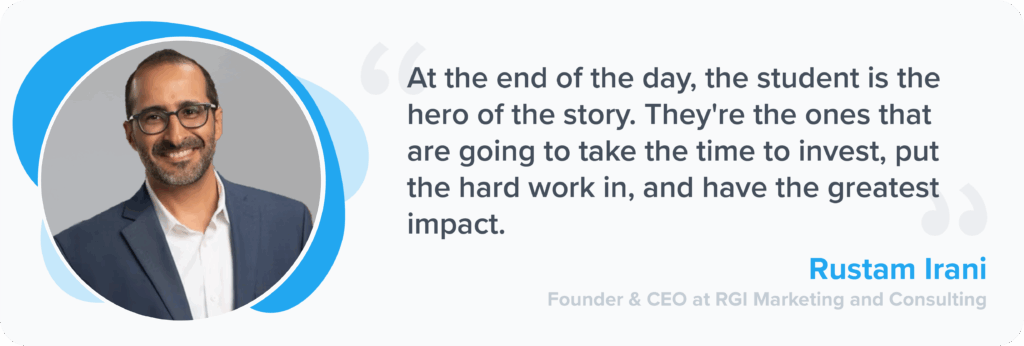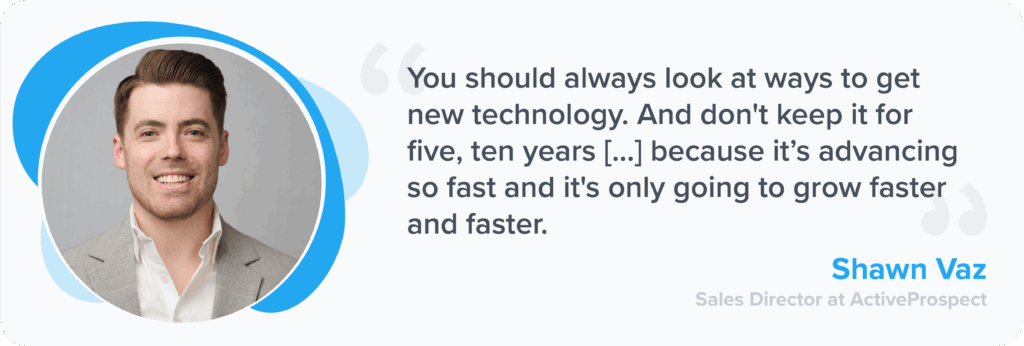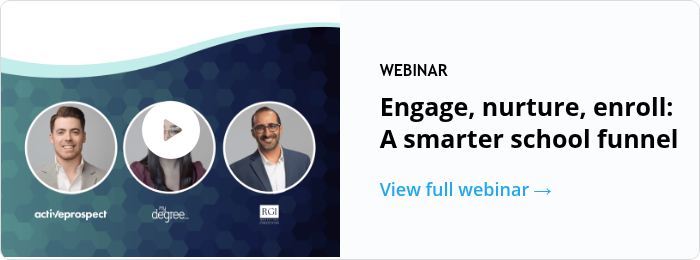Engage, nurture, enroll: A smarter school funnel

Higher-ed marketing is changing fast. Between shifting student expectations, evolving privacy rules, and the growing demand for proof of value, schools are rethinking how they attract, qualify, and support prospective students. In our first Education Perspective webinar, moderator Andrew Bailey sat down with three leaders who live this reality every day: Rustam Irani (Founder & CEO at RGI Marketing & Consulting), Bridget Granados (Director of Business Development at MyDegree.com), and Shawn Vaz (Sales Director at ActiveProspect).
The panel unpacked what’s working in 2025: Clearer messaging, tighter collaboration across teams, and consent-first operations that scale without sacrificing trust.
Here’s a full recap of the conversation and the practical takeaways you can apply now.
The big takeaways
- Make the student the hero. Lead with outcomes and proof that map to real goals.
- Align the FAM. Finance, Admissions, and Marketing should share one plan, one system, one set of numbers.
- Be consent-first. Verifiable proof + real-time scrubs turn risk control into conversion lift.
- Use both doors. Blend first- and third-party discovery; insist on transparency everywhere.
- Let data drive messaging. Feed dispositions and outcomes back into creative, targeting, and nurture.
- Modernize the machine. Automate intake, routing, and feedback loops to scale without losing control.
Let’s dive deeper into each of these topics.
1. Messaging that attracts (and doesn’t alienate)
Avoid over-segmentation traps
Bridget’s frontline view with schools is that marketers can get so granular with targeting that they accidentally exclude viable audiences. Education decisions cut across ages and life stages; not every message needs to be hyper-niche. A multifaceted campaign—mixing program spotlights, urgency tied to real milestones, lifestyle outcomes, and brand credibility—meets prospects where they are without boxing them out.

Program vs. brand: It depends on the moment
Rustam framed this through Google’s “micro-moments.” Some prospects are early and open-ended (“Is healthcare right for me?”). Others are deep in the funnel (“18-month billing & coding program under $X”). Use program-specific messages when intent is clear; use brand-level value when curiosity is broad. The right answer changes by touchpoint.
Don’t bait with grants/scholarships
Shawn cautioned that overusing words like “free,” “grant,” or “scholarship” inflates clicks but erodes trust and bogs down admissions with expectation resets. Use transparent language, explain what aid is available and how it works, and link to official resources. That honesty lowers friction and improves downstream conversion and retention.
Use urgency responsibly
Urgency works when it’s real—application windows, cohort start dates, FAFSA timing. It backfires when it’s vague or manufactured. Bridget’s advice: Tie urgency to verifiable deadlines and clear actions. Rustam added that the right reminder can wake up “slow-burn” leads sitting 300+ days in your pool.
Lead with outcomes, not superlatives
Prospects carry the cost and risk of enrollment. Shift the story from “state-of-the-art” to outcomes students care about: Time to completion, licensure or exam pass rates, job prospects, alumni stories, salary ranges, and flexibility (online, evening, hybrid). As Rustam put it, the student is the hero—your message should show the path from today’s goals to tomorrow’s results.

Quick action you can take: Audit your ad, landing page, and admissions script for consistency. Cut vague claims; elevate a few proof-points that matter to your audience. That alignment alone lifts trust and conversion.
2. Collaboration: Keep the “FAM” aligned
Great messaging fails without internal alignment. Rustam introduced a simple model: FAM = Finance, Admissions, Marketing. When those three are synced on budget, targets, and performance, schools make faster, better decisions. When they aren’t, you get disjointed goals, conflicting metrics (leads vs. enrollments), and campaign whiplash.
What alignment looks like:
- Shared systems and numbers. One CRM, one source of truth, one scoreboard.
- Cadence that builds empathy. Weekly check-ins; marketers listening to calls; admissions seeing ad creative; joint reviews of dispositions and objections.
- Transparent data for partners. If you work with agencies or vendors, treat them as an extension of the team. Give them visibility into dispositions, show rates, and reasons for no-start so they can optimize creative and targeting with you.
Bridget’s red flags for silos are: Communication only when performance dips, gated access to data, and “throw it over the fence” relationships with vendors. The antidote: Constant, candid collaboration, and clear goals everyone signs off on.
3. Consent-based marketing: Risk control that accelerates growth
Consent isn’t just a checkbox—it’s proof. Shawn underscored a core reality of 2025: TCPA litigation is up, and professional litigators actively hunt for compliance gaps. “Click-to-opt-in” without verifiable context (what was shown, where, when, and how) leaves schools and vendors exposed.
A consent-first framework does three things:
- Captures verifiable proof at opt-in (so you can confidently demonstrate when/where/how consent was given).
- Validates and scrubs data immediately (DNC lists, litigators, duplicates, obvious invalids).
- Keeps disclosures and opt-outs current across all your forms and partners.
Do it right and compliance becomes a growth enabler, not a brake: You reduce legal risk, improve call-center efficiency, and build trust that carries through to enrollment and persistence.
4. First-party vs. third-party leads: Use the whole ecosystem
There’s a trend toward first-party acquisition, but the panel emphasized it’s not either/or.
- First-party advantages: Higher transparency into consent and experience, tighter brand control, clearer intent signals, easier measurement back to outcomes.
- Third-party role: Strong publishers can deliver high-intent discovery and crucial first touches—especially when a prospective student is comparing options before they know your brand.
Rustam shared an analysis where ~20% of homepage traffic had previously encountered the school on a third-party destination. In a multi-touch world (think 10–12 exposures before action), these early impressions matter. The common denominator is transparency: Clear messaging, compliant forms, and clean hand-offs no matter where the student starts.
5. How compliance improves ROI (not just risk)
Bridget tied it together: When you lean into compliance and set correct expectations, you actually raise performance. Students who know what they’re opting into—and why—convert better, churn less, and are more satisfied through enrollment. That honesty drives:
- Higher connect rates (fewer frustrated prospects).
- Shorter cycles (less time spent resetting expectations).
- Better retention (students enroll in the right program for their goals).
6. Practical workflows that move the needle
Across the discussion, several tactical habits surfaced:
- Mine dispositions for messaging. Reasons for “not now” (cost concerns, timing, childcare, transport) should power nurture content and ad variations.
- Treat urgency as a service. Send true deadline nudges (FAFSA updates, cohort start dates) to the right segments at the right time.
- Fight fatigue with variety. Mix UGC-style video with static one-glance offers; test “short-short-long” ladders (hook, info, deep dive).
- Close the loop. Make sure outcomes (appointments, show rates, enrollments) flow back to optimize media and messaging.
- Modernize the stack. Technology ages fast. Regularly audit your lead intake, routing, enrichment, and consent capture to remove manual steps and reduce errors.

Conclusion
Winning enrollment today isn’t about a single tactic—it’s about a system. Put the student at the center, align your FAM around shared goals and one source of truth, and treat consent as a growth lever, not just a legal box. Use both “doors” to discovery (first- and third-party) with transparent hand-offs, then let real outcomes and disposition data sharpen your message. Finally, modernize the machine: Automate intake, scrubs, routing, and feedback loops so every click moves faster and farther.
If you do those six things consistently, you’ll build a school funnel that earns trust, scales responsibly, and converts—semester after semester.
If you missed the session live, watch the recording—there’s plenty more nuance in the full discussion, including detailed examples and audience questions. And if you’re ready to tighten the alignment across your own “fam,” book a free demo now to see how ActiveProspect can help.
DISCLAIMER: This page and all related links are provided for general informational and educational purposes only and are not legal advice. ActiveProspect does not warrant or guarantee this information will provide you with legal protection or compliance. Please consult with your legal counsel for legal and compliance advice. You are responsible for using any ActiveProspect Services in a legally compliant manner pursuant to ActiveProspect’s Terms of Service. Any quotes contained herein belong to the person(s) quoted and do not necessarily represent the views and/or opinions of ActiveProspect.




